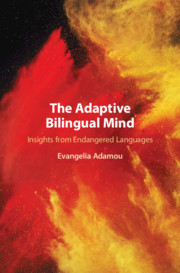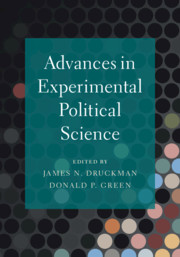Refine search
Actions for selected content:
32 results
Eliciting subjective real-valued beliefs
-
- Journal:
- Experimental Economics ,
- Published online by Cambridge University Press:
- 30 September 2025, pp. 1-20
-
- Article
-
- You have access
- Open access
- HTML
- Export citation
7 - Computational Geopolitics
-
- Book:
- The Great Disruption
- Published online:
- 05 June 2025
- Print publication:
- 19 June 2025, pp 169-196
-
- Chapter
- Export citation
Classification of natural language messages using a coordination game
-
- Journal:
- Experimental Economics / Volume 14 / Issue 1 / March 2011
- Published online by Cambridge University Press:
- 14 March 2025, pp. 1-14
-
- Article
- Export citation
Context matters
-
- Journal:
- Experimental Economics / Volume 21 / Issue 4 / December 2018
- Published online by Cambridge University Press:
- 14 March 2025, pp. 723-756
-
- Article
-
- You have access
- Open access
- HTML
- Export citation
An experimental examination of interbank markets
-
- Journal:
- Experimental Economics / Volume 22 / Issue 4 / December 2019
- Published online by Cambridge University Press:
- 14 March 2025, pp. 954-979
-
- Article
- Export citation
The Impact of Exchange Context on the Activation of Equity in Ultimatum Games
-
- Journal:
- Experimental Economics / Volume 3 / Issue 1 / June 2000
- Published online by Cambridge University Press:
- 14 March 2025, pp. 5-9
-
- Article
- Export citation
Beyond choice: investigating the sensitivity and validity of measures of strength of preference
-
- Journal:
- Experimental Economics / Volume 17 / Issue 4 / December 2014
- Published online by Cambridge University Press:
- 14 March 2025, pp. 537-563
-
- Article
-
- You have access
- Open access
- HTML
- Export citation
Competing Against Experienced and Inexperienced Players
-
- Journal:
- Experimental Economics / Volume 8 / Issue 1 / April 2005
- Published online by Cambridge University Press:
- 14 March 2025, pp. 55-75
-
- Article
- Export citation
Game form misconceptions are not necessary for a willingness-to-pay vs. willingness-to-accept gap
-
- Journal:
- Journal of the Economic Science Association / Volume 1 / Issue 1 / July 2015
- Published online by Cambridge University Press:
- 17 January 2025, pp. 72-85
-
- Article
- Export citation
16 - Experimental Methods
- from Part III - Data Collection
-
-
- Book:
- The Cambridge Handbook of Research Methods and Statistics for the Social and Behavioral Sciences
- Published online:
- 25 May 2023
- Print publication:
- 08 June 2023, pp 333-356
-
- Chapter
- Export citation
Afterword
-
-
- Book:
- Discourse-Pragmatic Variation and Change
- Published online:
- 14 July 2022
- Print publication:
- 28 July 2022, pp 293-300
-
- Chapter
- Export citation
2 - Tuning Language Processing Mechanisms to a Language’s Morphology without Decomposition: The Case of Semantic Transparency
- from Part I - In What Ways Is Language Processing Tuned to the Morphological Structure of a Language?
-
-
- Book:
- Morphological Diversity and Linguistic Cognition
- Published online:
- 19 May 2022
- Print publication:
- 02 June 2022, pp 31-55
-
- Chapter
- Export citation
3 - Productivity Effects on Morphological Processing in Maltese Auditory Word Recognition
- from Part I - In What Ways Is Language Processing Tuned to the Morphological Structure of a Language?
-
-
- Book:
- Morphological Diversity and Linguistic Cognition
- Published online:
- 19 May 2022
- Print publication:
- 02 June 2022, pp 56-78
-
- Chapter
- Export citation
7 - Learning Complex Morphological Patterns: The Role of Syncretism and Markedness
- from Part II - What Role Does Cue Informativity Play in Learning and How the Lexicon Evolves Over Time?
-
-
- Book:
- Morphological Diversity and Linguistic Cognition
- Published online:
- 19 May 2022
- Print publication:
- 02 June 2022, pp 182-200
-
- Chapter
- Export citation
When Do Voters Punish Corrupt Politicians? Experimental Evidence from a Field and Survey Experiment
-
- Journal:
- British Journal of Political Science / Volume 53 / Issue 2 / April 2023
- Published online by Cambridge University Press:
- 06 May 2022, pp. 728-739
-
- Article
- Export citation
11 - Anaphora: Experimental Methods for Investigating Coreference
- from Part II - Experimental Studies of Specific Phenomena
-
-
- Book:
- The Cambridge Handbook of Experimental Syntax
- Published online:
- 16 December 2021
- Print publication:
- 09 December 2021, pp 278-314
-
- Chapter
- Export citation
20 - Experimentation within the Social Identity Approach: History, Highlights, and Hurdles
- from Part III - Methodological Approaches
-
-
- Book:
- The Cambridge Handbook of Identity
- Published online:
- 29 October 2021
- Print publication:
- 11 November 2021, pp 435-460
-
- Chapter
- Export citation

The Adaptive Bilingual Mind
- Insights from Endangered Languages
-
- Published online:
- 23 April 2021
- Print publication:
- 15 April 2021
Experimental Measurement of Misperception in Political Beliefs
-
- Journal:
- Journal of Experimental Political Science / Volume 9 / Issue 2 / Summer 2022
- Published online by Cambridge University Press:
- 10 March 2021, pp. 241-254
-
- Article
- Export citation

Advances in Experimental Political Science
-
- Published online:
- 08 March 2021
- Print publication:
- 01 April 2021
